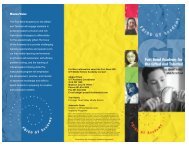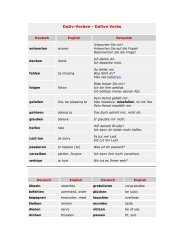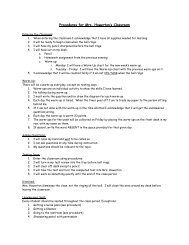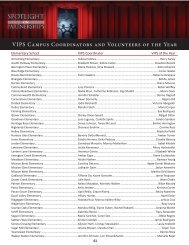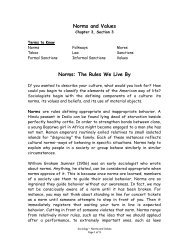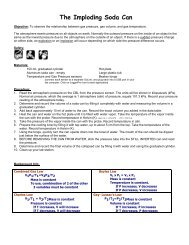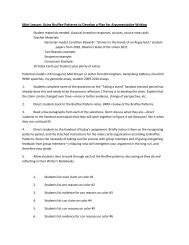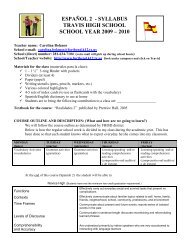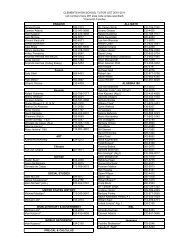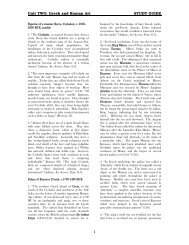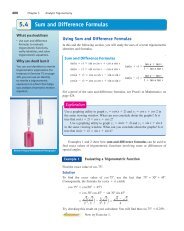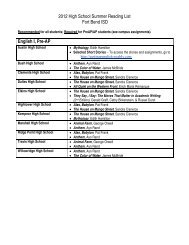CHAPTER 17
CHAPTER 17
CHAPTER 17
You also want an ePaper? Increase the reach of your titles
YUMPU automatically turns print PDFs into web optimized ePapers that Google loves.
<strong>CHAPTER</strong> <strong>17</strong><br />
ECONOMIC POLICYMAKING<br />
<strong>CHAPTER</strong> OUTLINE<br />
I. Government, Politics, and the Economy (pp. 542-549)<br />
A. Introduction<br />
1. Capitalism is an economic system in which individuals and corporations<br />
own the principal means of production.<br />
2. A mixed economy is a system in which the government, while not<br />
commanding the economy, is still deeply involved in economic decisions.<br />
3. Multinational corporations, businesses with vast holdings in many<br />
countries, dominate the world’s economy.<br />
B. Economic Policy at Work: An Illustration<br />
1. Government Regulation and Business Practices<br />
a. The main government regulatory agency responsible for the<br />
regulation of business practices is the Securities and Exchange<br />
Commission (SEC).<br />
b. Minimum wage is the legal minimum hourly wage for large<br />
employers.<br />
c. A labor union is a workers’ organization for bargaining with an<br />
employer.<br />
d. Collective bargaining consists of negotiations between<br />
representatives of labor unions and management to determine pay<br />
and acceptable working conditions.<br />
2. Wal-Mart and the World Economy<br />
C. “It’s the Economy, Stupid”: Voters, Politicians, and Economic Policy<br />
1. Economic conditions are the best single predictors of voters’ evaluation of<br />
the president.<br />
2. Democrats stress the importance of employment; Republicans stress the<br />
importance of inflation.<br />
D. Two Major Worries: Unemployment and Inflation<br />
1. The unemployment rate has a direct affect on government and politics.<br />
2. The Consumer Price Index (CPI) measures inflation (the rise in prices<br />
for consumer goods).<br />
II. Policies for Controlling the Economy (pp. 549-552)<br />
A. Laissez-faire is the principle that government should not meddle with the<br />
economy.<br />
B. Monetary Policy and “The Fed”<br />
314
1. Monetary policy is the manipulation of the supply of money and credit in<br />
private hands.<br />
2. Monetarism holds that the supply of money is the key to the nation's<br />
economic health.<br />
3. The main agency for making monetary policy is the Board of Governors<br />
of the Federal Reserve System.<br />
C. Fiscal Policy of Presidents and Parties<br />
1. Fiscal policy describes the impact of the federal budget on the economy.<br />
2. Keynesian economic theory holds that government spending can help the<br />
economy weather its normal ups and downs.<br />
3. Supply-side economics argues that the key task for government economic<br />
policy is to stimulate the supply of goods, not their demand.<br />
III. Why it is Hard to Control the Economy (pp. 552-553)<br />
A. Instruments for controlling the economy are difficult to use.<br />
B. Economic policies take a long time to implement.<br />
C. Most of the budget expenditures are uncontrollable.<br />
D. The private sector dominates the economy.<br />
IV. Politics, Policy, and the International Economy (pp. 553-556)<br />
A. Most emerging economies want to follow an economic policy of protectionism.<br />
B. The World Trade Organization (WTO) is an international organization that<br />
regulates international trade.<br />
C. The loss of American jobs overseas has become an important political issue.<br />
V. Arenas of Economic Policymaking (pp. 556-559)<br />
A. Business and Public Policy<br />
1. Corporate Corruption and Concentration<br />
a. Antitrust policy ensures competition and prevents monopoly.<br />
2. Regulating and Benefiting Business<br />
B. Consumer Policy: The Rise of the Consumer Lobby<br />
1. The Food and Drug Administration (FDA) has broad regulatory powers<br />
over the manufacturing, contents, marketing, and labeling of food and<br />
drugs.<br />
2. The Federal Trade Commission (FTC) has become a defender of<br />
consumer interests in truth in advertising.<br />
C. Labor and Government<br />
1. The National Labor Relations Act guarantees workers the right of<br />
collective bargaining.<br />
2. The Taft-Hartley Act continued to guarantee collective bargaining, but<br />
prohibited unfair practices by unions as well.<br />
3. Section 14B of Taft-Hartley permitted right-to-work laws that forbid labor<br />
contracts from requiring workers to join unions to hold their jobs.<br />
315
VI. Understanding Economic Policymaking (pp. 559-560)<br />
A. Democracy and Economic Policymaking<br />
B. Economic Policymaking and the Scope of Government<br />
VII. Summary (pp. 560-561)<br />
LEARNING OBJECTIVES<br />
After studying Chapter <strong>17</strong>, you should be able to:<br />
1. Understand the relationship between politics and the economy.<br />
2. Describe the policies and programs that policymakers use to affect the state of the<br />
economy.<br />
3. Explain why it is hard to control both the domestic and international economy.<br />
4. Discuss the major issues and policy directions that have been pursued in the areas<br />
of business, consumer, and labor policy.<br />
5. Understand the relationship between democracy, the scope of government, and<br />
economic policymaking in the United States.<br />
The following exercises will help you meet these objectives:<br />
Objective 1: Understand the relationship between politics and the economy.<br />
1. Briefly explain how Wal-Mart can be used to illustrate the following concepts:<br />
Inflation:<br />
Securities and Exchange Commission:<br />
Labor union:<br />
Collective bargaining:<br />
Occupational Health and Safety Administration:<br />
316
Globalization:<br />
2. Explain the basic difference between the Republican Party and the Democratic<br />
Party in terms of their approach to economic policies.<br />
Republicans:<br />
Democrats:<br />
3. Briefly explain how the unemployment rate is measured.<br />
4. What is meant by the Consumer Price Index (CPI) and why is it important?<br />
Objective 2: Describe the instruments and programs that policymakers use to affect the state of<br />
the economy.<br />
1. Explain how the Fed works to affect the supply of money and credit.<br />
2. What is meant by fiscal policy?<br />
3. Explain the basic differences between Keynesian economic theory and supplyside<br />
economics.<br />
Keynesian Theory:<br />
3<strong>17</strong>
Supply-Side Economics:<br />
Objective 3: Explain why it is hard to control both the domestic and international economy.<br />
1. What is meant by the “political business cycle”?<br />
2. Explain how the American capitalist system imposes restraints on controlling the<br />
economy.<br />
3. What are the major arguments for and against the World Trade Organization?<br />
Objective 4: Discuss the major issues and policy directions that have been pursued in the areas<br />
of business, consumer, and labor policy.<br />
1. Complete the following table listing one major congressional act and one major<br />
governmental policy for each of the arenas of economic policymaking discussed<br />
in the text.<br />
318
Arena Major Congressional Act Major Government Policy<br />
Business<br />
Consumers<br />
Labor<br />
2. List four ways in which the government benefits business.<br />
1.<br />
2.<br />
3.<br />
4.<br />
3. How does the Food and Drug Administration (FDA) and the Federal Trade<br />
Commission (FTC) benefit consumers?<br />
FDA:<br />
FTC:<br />
4. What were the main provisions of the National Labor Relations Act and the Taft-<br />
Hartley Act?<br />
National Labor Relations Act:<br />
Taft-Hartley Act:<br />
319
Objective 5: Understand the relationship between democracy, the scope of government, and<br />
economic policymaking in the United States.<br />
KEY TERMS<br />
1. What does the conflict about jobs in the 2004 election tell us about democracy<br />
and economic policymaking?<br />
2. What is the main difference between the liberal and conservative view of the<br />
scope of government in economic policymaking?<br />
Liberals:<br />
Identify and describe:<br />
capitalism<br />
mixed economy<br />
Conservatives:<br />
multinational corporation<br />
Securities and Exchange Commission<br />
320
minimum wage<br />
labor unions<br />
collective bargaining<br />
unemployment rate<br />
inflation<br />
Consumer Price Index (CPI)<br />
laissez-faire<br />
monetary policy<br />
monetarism<br />
Federal Reserve System<br />
fiscal policy<br />
Keynesian economic theory<br />
supply-side economics<br />
321
protectionism<br />
World Trade Organization (WTO)<br />
antitrust policy<br />
Food and Drug Administration (FDA)<br />
National Labor Relations Act<br />
Compare and contrast:<br />
capitalism and mixed economy<br />
labor union and collective bargaining<br />
inflation and Consumer Price Index (CPI)<br />
laissez-faire, monetarism, and Keynesian economic theory<br />
monetary policy and fiscal policy<br />
Keynesian economic theory and supply-side economics<br />
322
protectionism and World Trade Organization (WTO)<br />
National Labor Relations Act and collective bargaining<br />
Name that term:<br />
1. Some of these have annual budgets exceeding those of foreign countries.<br />
_________________________<br />
2. This agency was created during the New Deal to regulate stock fraud.<br />
_________________________<br />
3. Today this amounts to $5.15 per hour.<br />
_________________________<br />
4. The percentage of Americans actively seeking employment but unable to find<br />
work.<br />
_________________________<br />
5. It regulates the lending practices of banks.<br />
_________________________<br />
6. An economic theory popularized by President Reagan.<br />
_________________________<br />
7. This is used to ensure competition and prevent monopoly.<br />
_________________________<br />
323
8. This agency is responsible for ascertaining the safety and effectiveness of new<br />
drugs before approving them for marketing in the United States.<br />
_________________________<br />
USING YOUR UNDERSTANDING<br />
1. Find copies of the government's objective indicators of economic conditions—the<br />
unemployment and inflation rates—for some recent years. Government Internet<br />
sources would be a good place to start. Try your hand at plotting these indicators<br />
on a graph. Then try to locate an indicator of the importance of these issues on<br />
the public agenda, as measured by public opinion about the seriousness of these<br />
economic problems. Plot this indicator along with the objective indicators you<br />
found. If a national election occurred during the time frame you are considering,<br />
draw a line representing when the election occurred. Briefly describe what you<br />
found in terms of the relationship between the government's measurement of<br />
economic problems and their place on the public's agenda. If applicable, describe<br />
the apparent impact of the election on the indicators you plotted.<br />
2. Using newspapers, newsmagazines and/or the Internet, collect some current<br />
examples of economic policymaking in the United States. Try to find items that<br />
illustrate the different tools that policymakers use to try to control the economy<br />
and the different sectors of the economy that they seek to control. Consider the<br />
impact of the political party in power on current economic policymaking and<br />
whether or not it is consistent with what would be expected. Describe what you<br />
found in terms of the direction and impact of contemporary policies in the<br />
economic arena.<br />
REVIEW QUESTIONS<br />
Check the correct answer:<br />
1. The “father of the American economy” is<br />
a. George Washington.<br />
b. James Madison.<br />
c. Alexander Hamilton.<br />
d. Thomas Jefferson.<br />
2. A system in which the government, while not commanding the economy, is<br />
deeply involved in economic decisions is called<br />
a. capitalism.<br />
b. a mixed economy.<br />
c. socialism.<br />
d. communism.<br />
324
3. Some multinational corporations have budgets greater than many foreign<br />
governments.<br />
True<br />
False<br />
4. Wal-Mart<br />
a. generated as much revenue as the state of California collected in taxes.<br />
b. is partly responsible for the low rate of inflation in the United States.<br />
c. has been responsible for 12 percent of all productivity growth in the<br />
United States.<br />
d. all of the above<br />
5. The main regulatory agency responsible for regulation of business practices is the<br />
a. Federal Reserve Board.<br />
b. Securities and Exchange Commission.<br />
c. Department of Commerce.<br />
d. Justice Department.<br />
6. Economic conditions are the best single predictor of voters’ evaluations of how<br />
the president is doing his job.<br />
True<br />
False<br />
7. People who feel that unemployment is a serious national problem tend to<br />
a. lean toward the Democratic party.<br />
b. lean toward the Republican party.<br />
c. be unaffected by party politics.<br />
d. not vote.<br />
8. Which of the following statements is FALSE?<br />
a. Republicans appeal primarily to working-class voters.<br />
b. Voters concerned with unemployment are more likely to vote Democratic.<br />
c. The parties pay close attention to economic conditions when selecting<br />
their policies.<br />
d. Republicans worry more about inflation.<br />
9. The coalition behind the Republican Party is most likely to be concerned with<br />
a. inflation.<br />
b. inflation and unemployment.<br />
c. unemployment.<br />
d. expanding government's role.<br />
325
10. The Bureau of Labor Statistics measures the unemployment rate as the total<br />
number of adults without jobs.<br />
True<br />
False<br />
11. Our key measure of inflation is called the<br />
a. Consumer Price Index (CPI).<br />
b. Gross National Product (GNP).<br />
c. Laffer Curve.<br />
d. National Inflation Index (NII).<br />
12. Laissez-faire was an economic philosophy embraced by<br />
a. Herbert Hoover.<br />
b. Franklin D. Roosevelt.<br />
c. Lyndon Johnson.<br />
d. Jimmy Carter.<br />
13. Monetarists seek to keep the money supply in line with the<br />
a. Consumer Price Index.<br />
b. gross domestic product.<br />
c. unemployment rate.<br />
d. amount of available credit.<br />
14. According to monetarists, too much money and credit leads to<br />
a. recession.<br />
b. unemployment.<br />
c. inflation.<br />
d. a budget surplus.<br />
15. The Board of Governors of the Federal Reserve System<br />
a. consists of 12 members.<br />
b. belong to the president's party.<br />
c. regulates the lending practices of banks.<br />
d. is formally controlled by Congress and the president.<br />
16. The Fed attempts to affect the money supply by each of the following means<br />
EXCEPT<br />
a. determining tax rates.<br />
b. buying and selling government bonds.<br />
c. setting the federal funds rate.<br />
d. determining whether banks have more or less money to lend.<br />
326
<strong>17</strong>. The financial dealings of the Federal Reserve Board directly or indirectly affect<br />
a. interest rates.<br />
b. inflation.<br />
c. availability of jobs.<br />
d. all of the above<br />
18. The president has ultimate influence over the policies of the Federal Reserve<br />
System.<br />
True<br />
False<br />
19. The impact of the federal budget—taxes, spending, and borrowing—on the<br />
economy describes<br />
a. laissez-faire policy.<br />
b. monetary policy.<br />
c. fiscal policy.<br />
d. economic policy.<br />
20. Fiscal policy is almost entirely determined by<br />
a. Congress and the president.<br />
b. the Federal Reserve System.<br />
c. the Internal Revenue Service.<br />
d. the Office of Management and Budget.<br />
21. The dominant economic philosophy most associated with the Roosevelt<br />
administration was<br />
a. laissez-faire.<br />
b. monetarism.<br />
c. Keynesianism.<br />
d. supply-side economics.<br />
22. Which of the following statements is TRUE?<br />
a. Fiscal policy uses the Federal Reserve System.<br />
b. Supply-side economics holds that tax cuts will stimulate the economy.<br />
c. Conservative politicians have long favored Keynesian economic theory.<br />
d. The Laffer Curve shows the relationship between inflation and<br />
unemployment.<br />
23. (bonus) Who, according to legend, wrote his economic theory on the back of a<br />
cocktail napkin?<br />
a. Karl Marx<br />
b. John Maynard Keynes<br />
c. Arthur Laffer<br />
d. Adam Smith<br />
327
24. Economists have shown that decisions to artificially influence the economy at<br />
election time have been made on a regular basis.<br />
True<br />
False<br />
25. Our capitalist system presents a restraint on controlling the economy because<br />
a. the private sector dominates the economy.<br />
b. big business dominates economic policymaking.<br />
c. no one can predict American consumer behavior.<br />
d. none of the above<br />
26. Emerging economies tend to favor an economic policy of<br />
a. Keynesianism.<br />
b. protectionism.<br />
c. globalization.<br />
d. laissez-faire capitalism.<br />
27. Which of the following statements regarding free trade is FALSE?<br />
a. Both Republican and Democratic presidents have supported free trade.<br />
b. The World Trade Organization was established to promote free trade.<br />
c. Free trade became increasingly popular after World War II.<br />
d. Trade unions tend to be the strongest supporters of free trade.<br />
28. (bonus) Who said, "the business of America is business"?<br />
a. John Maynard Keynes<br />
b. Calvin Coolidge<br />
c. Herbert Hoover<br />
d. Ronald Reagan<br />
29. At the center of the American economy has long stood the<br />
a. corporation.<br />
b. family farm.<br />
c. consumer.<br />
d. labor union.<br />
30. The beginning of the twenty-first century showed<br />
a. a new respect for American corporations.<br />
b. a sharp rise in the stock market.<br />
c. an increase in corporate corruption.<br />
d. a decrease in corporate concentration.<br />
328
31. Since the 1980s, corporate capitalism was characterized by<br />
a. hard times.<br />
b. increased regulation.<br />
c. an increased number of mergers.<br />
d. nationalism.<br />
32. Antitrust policy is implemented by the<br />
a. Justice Department.<br />
b. General Service Administration.<br />
c. Small Business Administration.<br />
d. Patent Office.<br />
33. The Clinton administration filed a major antitrust suit against<br />
a. International Business Machines (IBM).<br />
b. General Motors.<br />
c. Microsoft.<br />
d. Exxon.<br />
34. The government aids American business by<br />
a. collecting data on products and markets.<br />
b. issuing and protecting patents.<br />
c. providing research and development funds.<br />
d. all of the above<br />
35. The first major consumer protection policy was the<br />
a. Food and Drug Act.<br />
b. Consumer Product Safety Act.<br />
c. Consumer Credit Protection Act.<br />
d. Wagner Act.<br />
36. The agency that became a zealous defender of consumer interests in truth in<br />
advertising in the 1960s and 1970s was the<br />
a. Small Business Administration.<br />
b. Food and Drug Administration.<br />
c. Consumer Product Safety Commission.<br />
d. Federal Trade Commission.<br />
37. Perhaps the biggest change in economic policymaking over the past century has<br />
been the virtual 180-degree turn in public policy toward<br />
a. consumers.<br />
b. business.<br />
c. labor unions.<br />
d. farmers.<br />
329
38. The National Labor Relations Act<br />
a. provided for a right-to-work law.<br />
b. enforced "yellow dog contracts."<br />
c. exempted unions from antitrust laws.<br />
d. guaranteed the right of collective bargaining.<br />
39. The Taft-Hartley Act<br />
a. continued to guarantee unions the right of collective bargaining.<br />
b. gave the president a means to halt major strikes.<br />
c. permitted states to adopt right-to-work laws.<br />
d. all of the above<br />
40. Right-to-work laws forbid labor contracts from requiring workers to join unions<br />
to hold their jobs.<br />
True<br />
False<br />
41. Voters rarely expect politicians to do much about the economy.<br />
True<br />
False<br />
42. For the last two generations, U.S. policymakers have followed the near-universal<br />
advice of economists by supporting<br />
a. protectionism.<br />
b. free trade.<br />
c. supply-side economics.<br />
d. regulation.<br />
43. Democracy regularly facilitates an economic policy that looks after general<br />
interests for long-term gain and ignores specific interests of particular groups.<br />
True<br />
False<br />
44. In general, liberals would favor letting business and the free market create new<br />
jobs and prepare people for them.<br />
True<br />
False<br />
45. Liberals tend to focus on the imperfections of<br />
a. government.<br />
b. the market.<br />
c. regulatory agencies.<br />
d. states.<br />
330
ESSAY QUESTIONS<br />
1. How are politics and economics related? Why do politicians and policymakers<br />
try to control the economy?<br />
2. What are the principle instruments available to policymakers for controlling the<br />
economy? Compare monetarism, Keynesian economic theory, and supply-side<br />
economics.<br />
3. What obstacles does the government face in attempting to control the domestic<br />
and international economy?<br />
4. What policies has government used to try to control American business? Has the<br />
government been successful?<br />
5. When and why did the consumer movement emerge? What are some of the major<br />
developments in consumer policy?<br />
6. How has government policy toward labor changed in the last century? What<br />
public policies have emerged to protect workers?<br />
7. How closely does economic policymaking in the United States conform to<br />
democratic theory?<br />
331



